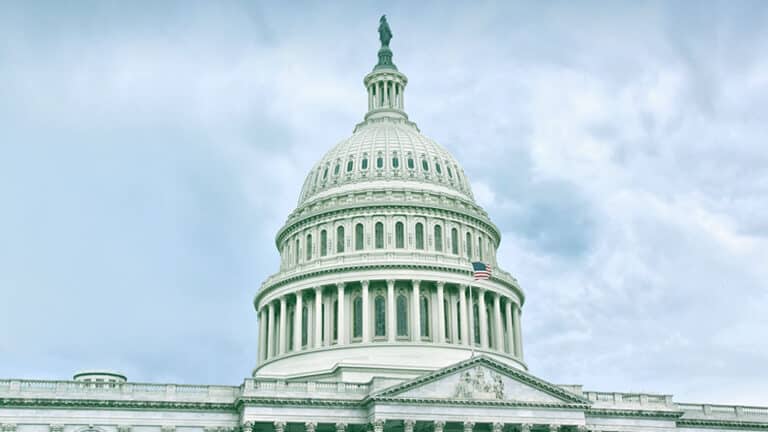
From Libby Cantrill, Head of Public Policy, PIMCO.
What is happening? It is day 6 of the U.S. government shutdown with both sides ostensibly more dug-in and with no reopening in-sight, affecting an estimated ~2 million federal workers (including ~550K workers who are being furloughed and the balance who are “excepted” employees, meaning they must work but do not get paid here). The House – an essential player in a potential reopening – is not planning to be in session this week, suggesting that the government will remain closed for at least another week.
Over the past few weeks, our concern has been that should the government shut down, there may not be a clear catalyst for it to reopen, which looks increasingly like the case, at least 6 days in.
Indeed, both sides seem even more entrenched– and more convinced they are on the winning side of the political argument with Republicans pointing out that their “clean” funding bill is exactly what Democrats have voted for in the past (which is true).
Meanwhile, Democrats, who have failed to find their voice since their loss last November, are making the case that Republicans should come to the table to negotiate three other issues in addition to funding the government, which include 1) restoring the ~$1 trillion in cuts to Medicaid that were part of the recent tax bill (the “One Big Beautiful Bill” or OB3) that are expected to hit in 2027; 2) extending expiring expanded subsidies to purchase Obamacare, which was part of the 2021 covid relief bill and are set to expire at the end of 2025 (and could lead to the doubling of premiums for some folks); and 3)preventing President Trump from using “pocket rescissions” a wonky tool that allows the executive branch to pare-back spending. Republicans have indicated they may be open to talking about these but only once the government reopens.
No off-ramps? There will be another vote in the Senate today on a straight-line funding bill that lasts until Thanksgiving, which is an effort to try to pressure more Democrats to cross-over to support the reopening. As of now, Senators Fetterman (D-PA), Cortez-Masto (D-NV), and King (I-ME) have all voted to reopen the government, but that vote, which needs 60 votes to clear (i.e., at least 8 Democrats) is likely to continue to fall short when it is voted on today. What could reflect a thaw in positions is if more Democrats break and join Republicans to vote to reopen the government today, which could indicate a general shakiness of Democrats’ position (there are few signs of this now, however).
What could be the possible catalysts for reopening? In the most recent full shutdown back in 2013, the debt ceiling deadline proved to be the catalyst to reopen the government; this time-around there are few on the horizon, however. Some potential inflection points could include:
- Week of October 6th/ October 13th: WIC (Women Infant Children) supplemental nutrition program will run out of money (here), which is not typically a great headline for Congress, since it impacts all members districts and senators’ states. Regardless, it does not seem enough of a catalyst to lead to a reopening at this point.
- October 15th: The first missed paycheck for members of the military, including those on active duty. Trump may be able to use some of the $150bn funds earmarked for the Defense Department as part of the recently-passed tax bill to defray the impact and pay services members, but that is unclear. In previous recent shutdowns, Congress has passed the “Pay Our Military Act” to ensure no pay disruption to active service members but they have not passed that this time.
- November 1st: The date when the majority of states begin “open enrollment” for those getting health insurance under the Affordable Care Act (aka Obamacare) and when notifications will start going out informing enrollees that premiums will increase. It is estimated that more than 75% of those who will be impacted by the expiring generous subsidies live in states that President Trump won and that the subsidies remain popular with the majority of Americans according to KFF (here). This might be a catalyst but keep in mind that Hill Republicans are generally not supportive of these subsidies, having voted against them in the past and suggesting that it is appropriate for them to end since covid is over (to make these permanent would cost $300bn for those counting at home).
- November 21st: The last day before Congress breaks for Thanksgiving, which is typically the busiest travel time in the U.S. While many FAA and TSA workers are deemed “essential,” so are required to work, they are not paid during shutdowns, which in the past has become increasingly problematic; indeed, the last partial – and longest – shutdown in history during Trump’s first presidency ended partly due to concerns about airplane and airport safety.
How is it playing politically? Voters by and large do not like government shutdowns, and this time-around does not look all that different. While Republicans and President Trump are shouldering marginally more blame, voters are unhappy with both parties according to recent polling (here), and although there is more support for the extension of the ACA subsidies (here), most still do not support Democrats shutting down the government over it. At the same time, Democrats who have had a hard (impossible?) time breaking through in the era of Trump 2.0 seem happy (for now) that their message is resonating with their base (for now).
Bottom line: As we have mentioned before, shutdowns are easy, but reopenings are harder, and this one – which is the first full shutdown since 2013 – seems particularly intractable, at least for now. The implication for markets (which seem quite impervious to this so far) is that the longer the shutdown lasts, the more “non-linear” the impacts may be: While ~2 million federal works who are not seeing pay will be repaid once the government reopens, there is a question around the millions of workers who support the work the government does and the associated lost activity that may not be regained. That total loss in GDP activity – 0.1% to 0.2% / week (which accelerates as the shutdown goes on) – in addition the “data desert” from the lack of data disclosure and data collection – could complicate the Fed’s job, which continues to see cross-currents in this economy – from slowing payrolls and weaker consumption to accelerating parts of CPI with 60% of items growing faster than 3% (here). In other words, a shutdown could simply further exacerbate the Fed’s already-difficult job going into the end of October when the FOMC will convene.





























